Patient E., 42 years old, came to the clinic with complaints of facial skeletonization. Diagnosis – lipoatrophy of the cheek area. Facial changes were successfully corrected by introducing fillers based on stabilized hyaluronic acid and botulinum toxin type A into the problem area.
Correction algorithm was shared with readers of estet-portal.com by MD, plastic surgeon, head of the Department of Plastic Surgery, Faculty of Postgraduate Education, St. Petersburg State Medical University. I.P. Pavlova, full member of the American Society of Aesthetic Plastic Surgeons (ASAPS), full member of the Russian Society of Plastic Reconstructive Aesthetic Surgeons (OPRES) Irina Khrustaleva.
- Clinical case: injection of fillers to correct lipoatrophy
- Recommendations for correcting facial lipoatrophy
- Algorithm of the Facial Lipoatrophy Correction Procedure
Clinical case: injection of fillers to correct lipoatrophy
Patient history: the patient first noticed a decrease in the volume of subcutaneous fat of the face in adolescence, at about 13 & ndash;14 years. The process progressed until the age of 18, after which, having reached a peak, it stopped. The volume of the soft tissues of the face, according to the patient, remained unchanged during all subsequent years. Denies fluctuations in body weight.
Local status: pronounced skeletalization (loss of soft tissue volume) of the face. Symmetrically, superficial and deep fat packages of the anterior and lateral parts of the middle and lower thirds of the face are almost completely absent.
At rest and during articulation, superficial mimic and masticatory muscles are visualized. The latter are clearly hypertrophied. The bite is orthognathic, there is a tendency to pathological abrasion of the teeth (not pronounced at the time of examination). Facial skin is thin, mobile, with reduced tone.
Diagnosis: Bilateral symmetrical lipoatrophy of the middle and lower thirds of the face.
Recommendations for correcting facial lipoatrophy
An additional examination is needed to clarify the etiopathogenesis of the disease. From the point of view of aesthetic correction, it is necessary to carry out:
- Contour injection of the middle and lower third of the face with a preparation based on stabilized hyaluronic acid;
- Relaxation of masticatory muscles to reduce their contouring by the introduction of a preparation of botulinum toxin type A.
To restore the volume of the soft tissues of the face, you can use your own adipose tissue, fillers with a stimulating effect or stabilized hyaluronic acid preparations.
Blue Light: Skin Enemy Number One
Algorithm of the facial lipoatrophy correction procedure
The choice of a hyaluronic acid filler in this particular case was driven by the patient's desire for an immediate, non-surgical result.
We settled on Yvoire Volume (LG Life Science, South Korea) — biphasic filler with a particle size of about 900 microns and a hyaluronic acid concentration of 22 mg/ml.
When describing this drug, they often talk about its "hybrid properties": combining a pronounced ability to create and maintain soft tissue volume at the injection site due to the high modulus of elasticity G’ (characteristic of biphasic fillers) and sufficiently high plasticity, which facilitates modeling in tissues and causes uniform distribution due to the low fluidity modulus G” (characteristics of monophasic fillers).
To restore the volume of the soft tissues of the face, autologous adipose tissue, stimulating fillers or preparations based on stabilized hyaluronic acid can be used.
For the clinical case under discussion, we needed to add a large additional volume in the middle and lower thirds of the face (and without the risk of migration of the drug injected in a significant amount), while avoiding filler contouring in a patient with very thin skin if possible. According to our assumptions, the Yvoire Volume filler should have provided the optimal result.
"Academy of Scientific Beauty" -distributor of hyaluronic acid fillers Yvoire
3D Face Scan
Before injection contouring, a face scan was performed using a 3D scanner, which made it possible to identify the asymmetry of the volume indicators of the right and left halves of the face and calculate the estimated volumes of the drug to be injected into the area of lipoatrophy (comparison of the initial picture with the predicted virtual result).
From the obtained 3D scan data, it became obvious that 9.6 ml of filler should be injected into the buccal region on the right, on the left — 13.5 ml. The total volume of the drug — 23.1 ml.
The predicted result of the correction was discussed with the patient. Before injections, markings were made on the face with the designation of areas of severe lipoatrophy. After disinfection of the skin with an alcohol solution, conduction and infiltration anesthesia was performed using ultracain forte D-S in a total volume of 2 ml.
Protocol for complex correction of the periorbital area
Features of the introduction of dermal filler
The filler was injected using a 25G cannula 70 mm long after a preliminary skin puncture with a larger needle.
Yvoire Volume, presented by «Academy of Scientific Beauty», was injected in a linear retrograde way in a fan technique from the periphery to the center and from top to bottom subcutaneously.
Using the fan technique, it is possible to introduce a fairly large volume of filler, while its distribution over the vectors allows the introduction of a fixed and not very large volume into each of them, which ensures the prevention of displacement and migration of the drug.
Due to the purposeful formation of the crossing of vectors, it is possible to obtain additional volume in the planned zone.
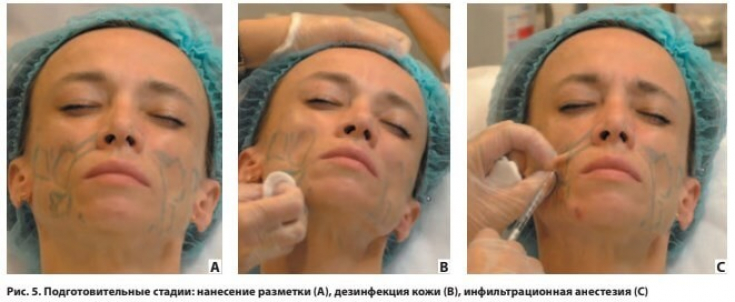
The first point of insertion of the cannula — mandibular (Fig. 6).
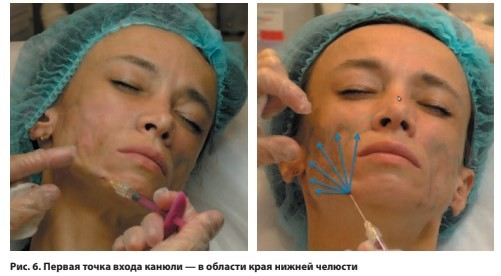
Further, the drug was injected in the same way from the bottom up from the second point — opposite the tragus, retreating 2.0 cm from the auricle (Fig. 7).
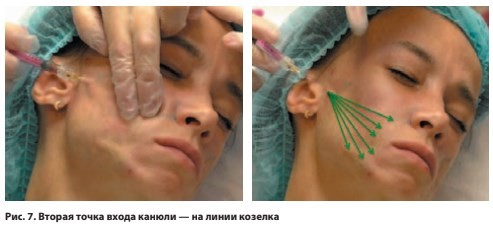
The insertion of the filler from the third point in the projection of the lower edge of the masticatory muscle in the region of the angle of the lower jaw is shown in Fig. 8.
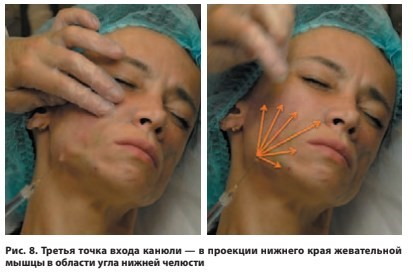
As a result, the filler was introduced using the technique of intersecting vectors, filling the entire marked depression zone fairly evenly. After each series of injections, kneading and modeling of the drug was performed. Let us immediately clarify that we decided not to administer the entire estimated volume of the drug at once (23 ml), but to limit ourselves to a slightly smaller, but still significant volume of — 14 ml, distributing it evenly on both sides (7 ml each). Correction of asymmetry and, if necessary, addition of volume was planned to be carried out at the next stage at the request of the patient.
At the end of the procedure, botulinum toxin injections were made into the masticatory muscles to correct hypertrophy: 25 U in 3 points on each side (total dose 150 U) (Fig. 10). Injections were performed intramuscularly, the needle was inserted perpendicular to the skin surface. Thus, the filler and botulinum toxin were injected at fundamentally different anatomical levels, which made it possible to inject both drugs into the same area in one procedure.
After the injection, a fixation bandage was applied using patches to prevent displacement of the large-sized filler and to prevent the development of swelling. The patient was given recommendations to limit physical activity, taking only soft and liquid food during the week.
Practical case: correction of local facial fat deposits
Finishing touch: additional correction
However, with an overall significant improvement in the clinical picture, local relief irregularities were observed in areas of the most pronounced tissue thinning.
Cellular lipomodulation: how to remove nasolabial folds
The patient was offered an additional procedure for correcting skin profile defects, which was carried out 4 months after the initial procedure.
For a more complete restoration of the volume, 4 ml of Yvoire Volume, presented by the company «Academy of Scientific Beauty».
The skin profile was corrected using 1 ml of Yvoire Classic (LG Life Science, South Korea), a biphasic filler based on stabilized hyaluronic acid with a particle size of about 400 µm. This drug is less viscous and more plastic, designed to correct wrinkles and folds on the face. The filler was injected intradermally using the "sandwich" technique. The result of the correction is shown in Figure 12.
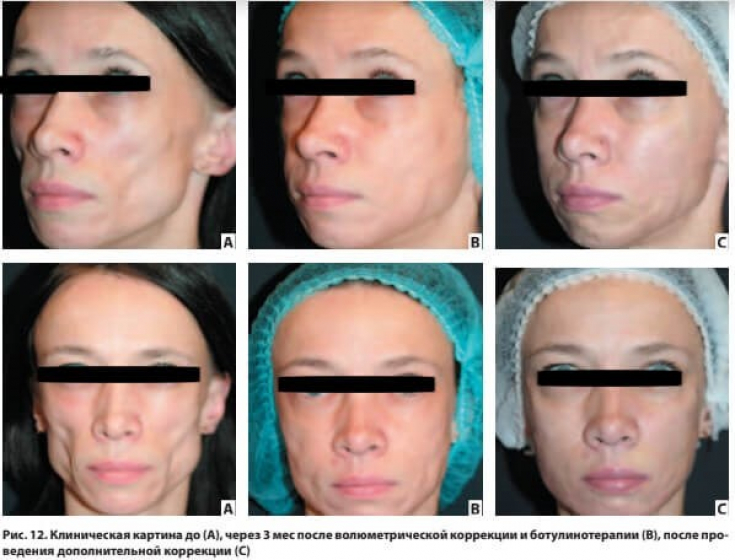
Thus, contour injection plastic surgery is a method of effective aesthetic correction of facial lipoatrophy. By choosing the right dermal fillers, you can achieve a long-lasting and pronounced effect.







Add a comment